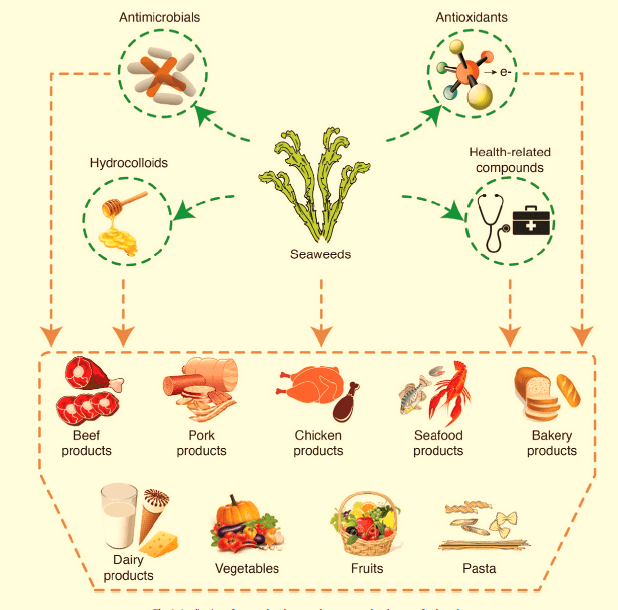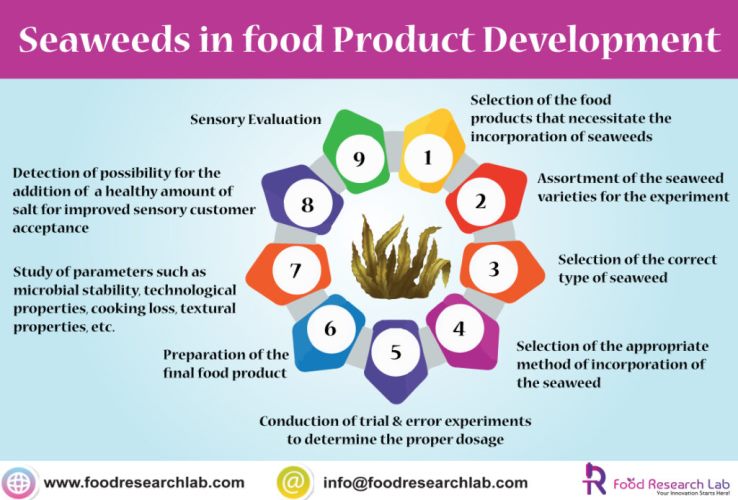Aquatic macroalgae or seaweeds are categorized based on pigmentation, nature of photosynthesis and finally, their morphology. Typically, we can find blue-green algae, red algae, green algae and brown algae. The edible seaweeds are an excellent source of vitamins, minerals, amino acids, dietary fibres, antioxidants, and polyunsaturated fatty acids (PUFA).
Applications of Seaweeds in Foods Industry
Aquatic macroalgae or seaweeds are categorized based on pigmentation, nature of photosynthesis and finally, their morphology. Typically, we can find blue-green algae, red algae, green algae and brown algae. The edible seaweeds are an excellent source of vitamins, minerals, amino acids, dietary fibres, antioxidants, and polyunsaturated fatty acids (PUFA).
Many researchers have shown that these edible seaweeds have therapeutic, thickening and gelling properties and contain antioxidant and antimicrobial properties. Dry seaweed powders are used against lipid oxidation and oxidative stress in foods and live issues. Polysaccharides extracted from seaweed are a great source of soluble and insoluble dietary fibres, exhibiting high water holding capacity, proven better than cellulosic fibres. In addition to the functional properties, seaweeds also showcase health benefits such as nutritional supplements, protection against obesity, hypertension and diabetes. For example, bioactive peptides, anticoagulant and anticancer activities are seen in algal fucans, galactans and alginates.


Chemical composition
Seaweeds are rich in vitamins (A, B1, B6, B12, C, D and E), folic acid, and pantothenic acid, minerals (calcium (Ca), magnesium (Mg), Iron (Fe), zinc (Zn), Iodine (I) and manganese (Mn). In terms of macronutrients, seaweeds contain high amounts of macronutrients, such as proteins, carbohydrates, fibres and fats; polysaccharides have been proven to improve the structural strength of foods.
Antioxidant potential
Seaweed phlorotannins have been shown to scavenge free radicals such as superoxide, ferrous ions, peroxyl and nitric radicals. Compared to catechin, ascorbic acid, phlorotannins and α-tocopherol isolated from Eisenia bicyclis, Ecklonia cava, and Ecklonia kurome have enhanced (around 2–10 times) antioxidant activity. Water extract of Scytosiphon lomentaria resulted in solid antioxidant activity in linoleic acid peroxidation assay, equivalent to 22 mg of catechin/ g of dry sample.
Antimicrobial properties
Seaweed extracts have evoked interest as sources of natural products with enhanced antimicrobial activities. The compound was responsible for antibacterial activity against Staphylococcus aureus, 1,8-dihydroxy. Anthraquinone was isolated from red algae Porphyra haitanensis. In another study, marine macroalgae, Magnoliophyta was investigated for the antibacterial and antifungal activities. The extracts were tested using organic and inorganic solvent extraction against Escherichia coli, Listeriamonocytogenes, Salmonella enterica, Agrobacterium tumefaciens, Pseudomonas aeruginosa, Saccharomyces cerevisiae, yeast and fungi. Similarly, E. cava (brown algae) extract was investigated for its antibacterial and synergistic activity against antibiotic-resistant species.
Hydrocolloid properties
Hydrocolloids are employed to obtain stable emulsions, suspensions, foams, increase gelation and viscous behaviours. Agar hydrocolloid is extracted from the red algae genera Gelidium and Gracilaria. Agar contains many soluble solids such as sugars and is mainly used for thickening and gelling properties. Due to its extreme melting temperatures, Agar can hold the sugar and prevent crystallization and is used for preparing glazing and icing in the bakery.
The widely produced algal polysaccharides called alginates are extracted from brown seaweeds. Alginate is made up of 1,4-β-D-mannuronic acid and α-L-guluronic acid, making it a linear polymer. Unlike Agar, alginates do not melt at extreme temperatures, form cross-linked gels, and are used extensively in meat and vegetable products. Carrageenans consist of sulphate polysaccharides that are produced in red seaweeds. Carrageenans are used in the dairy industry to stabilize ice creams, yoghurt and cheese.
Nutritional, textural, and organoleptic properties
| Food products | Seaweed | Result |
| Pork | 1000 mg/kg Ulva lactuca & Ulva rigida | pH not affected Microbial growth delayed More effective against lipid oxidation in comparison to grape and tea extracts. |
| Pork | 2.5% and 5.6% Sea Spaghetti, Wakame and Nori | Improved water- and fat-binding properties Enhanced hardness and chewiness of the final cooked products |
| Frankfurters & breakfast sausages | 3.3% to 5.5% Sea Spaghetti, Sea tangle | Improved cooking loss and lowered emulsion stability. Healthier meat products with lower fat and salt content. Improved water and fat binding. Improved sensory properties. Shelf life was not influenced by seaweed. |
| Beef products | 10 to 40 % Sea Spaghetti | Reduced the cooking losses Increased tenderness (≈50%), dietary fibre level, Lower microbiological counts and lipid oxidation |
| Chicken products | 3% Sea Spaghetti, Wakame | Increased the purge loss Decreased the cooking loss High levels of total viable counts, lactic acid bacteria and spermidine. Aided in maintaining properties of poultry steaks with low salt content. |
| Seafood products | 300 mg /kg 3.7 and 3.8 g/100 g of Aq & Et extracts Fucus vesiculosus | Aq and Et extracts did not affect lipid oxidation. No off-flavours was detected High reducing capacity, high DPPH radical scavenging and high oxygen absorbance were observed. Protection against lipid oxidation in muscle foods. Phlorotannins were highlighted as a natural antioxidant in fish products. |
| Bread | 2 % to 8 % Palmaria palmate Kappaphycus alvarezii 5% to 15% Sea Spaghetti | The addition of palmate protein hydrolysate did not influence the texture or sensory properties. Increased water absorption in the dough Reduced stickiness properties. Higher values of firmness Edible texture and colour in breadsticks. Max levels of total dietary fibre (7.95%) and phytochemicals (total phenolic content: 138.25 mg GAE/100 g db & DPPH: 65.01%. |
| Noodle and Pasta | 3 % to 8 % Monostroma nitidum Wakame | Foods with 6% seaweed had a higher yield. The final product had less tensile strength. High levels of seaweed resulted in less extensibility. Increased water absorption resulted in soft textural intensity. Pasta preparation was preferred with 10% seaweed. Improved amino acid and fatty acid profile. Improved nutritional value of the final product. The rigorousness of pasta did not affect Fucoxanthin Gluten formation was obtained up to 20 % seaweed concentration. |
| Dairy products | 0.25 and 0.5% Ascophyllum nodosum and Fucus vesiculosus | Aqueous extracts were preferred Varying degree of antioxidant activity observed. Improved milk quality Improved shelf-life characteristics. |
In Summary
The incorporation of seaweed into food systems can enhance shelf-life, nutrition, textural and organoleptic properties. The effects depend on the amount and type of seaweed used in the formulation; thus, careful optimization is required. Reviewing the composition of seaweed and its impact on obesity, hypertension, and diabetes should be considered. Although tremendous applications exist, there are still challenges in their commercialization due to various aspects.
Food Research Lab can help you solve these problems related to the formulation of products with seaweed. FRL is for food and nutraceutical manufacturers and those companies involved in NPD and developing spec without manufacturing. FRL allows you to improve all phases and aspects of new product development, such as original specification, ideation, shelf-life, packaging. Additionally, you can get them out to market quicker than ever before.

Let’s create something Innovative and Delicious together
Food Research Lab strives for excellence in new Food, Beverage and Nutraceutical Product Research and Development by offering cutting edge scientific analysis and expertise.




